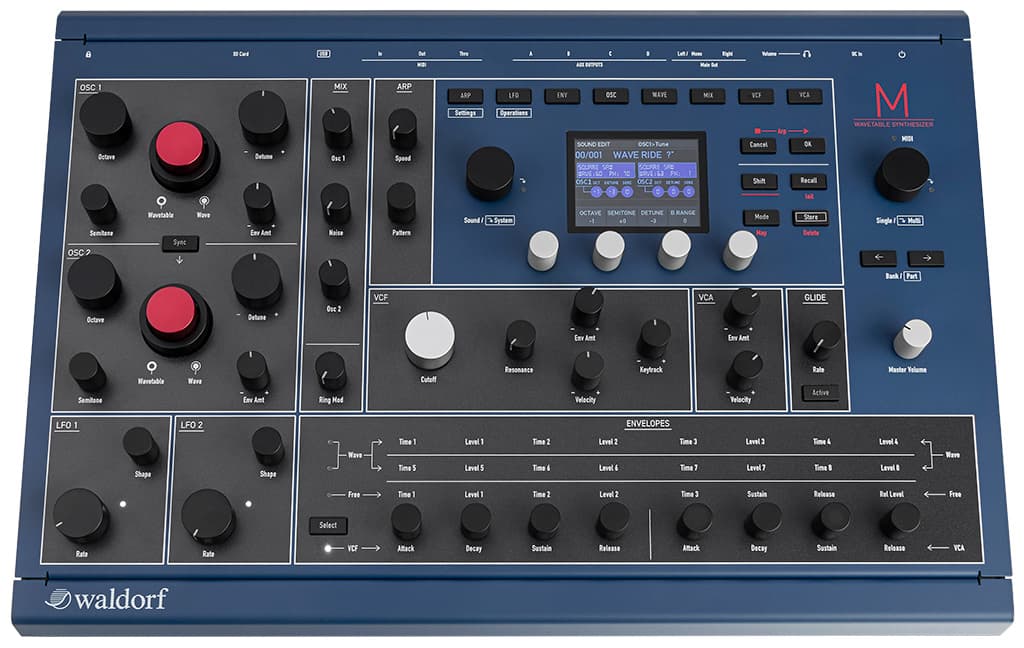
Review: Waldorf M
The legendary Microwave lives on, with extra power and punch.
There’s something romantic, mystical even, about how the most revered synths to this day can largely trace their roots to the innovators of the ’60s, ’70s and ’80s. Names such as Bob Moog, Dave Smith, Tom Oberheim and others are invoked in hush tones.
And so it is with synth stalwart, Waldorf. It all started with Wolfgang Palm — another legend who’s jersey has long been retired in the synth hall of fame.
The Waldorf Microwave was released in 1989 and despite its programming challenges, you could find it in studios everywhere.
It was most people’s introduction to wavetable synthesis. The Microwave used a digital/analogue hybrid setup in which digitally sampled wavetables are processed through analogue VCA envelope and filter sections. It had a different voice to the analogue synths before it and distinct to the contemporary sample+synthesis synths of the time. It was a genuinely alternative colour in the palette of electronic musicians of the time.
In the late ’90s, Waldorf followed the Microwave up with the Microwave II/XT/XTk, with its 16-bit (rather than 8-bit) wavetable oscillator. That said, the approach was largely same.
Now, 20-something years later, Waldorf has modernised the Microwave for a new generation. It’s the ‘M’.
COOKING WITH THE MICROWAVE
If you’re new to Waldorf and you’re wondering what sort of name ‘M’ is, then I can only refer to you to previous offerings such as the Blofeld and Q to answer that. As yet, there’s no Odd Job or Jaws in the pipeline.
If the M is a modernised, reimagine Microwave, it does so pretty darn sympathetically. If you want a Microwave, the M can do it for you in a way such that you won’t be able to hear the difference.
Ditto the Microwave XT. Wish you could have afforded a Wave? There are Wave presets as well.
Firstly, let’s quickly whip around the features:
- Two wavetable oscillators — 96 factory wavetables and 32 slots for user wavetables.
- Analogue low-pass filter: 24dB/Oct VCF (SSI 2144 Improved Ladder Type) with saturation
- Analogue stereo VCA for each voice
- 4 Envelope Generators; 8-point loopable time/level Wave envelope generator, VCF and VCA ADSR envelopes and a free assignable loopable 4 points time/level envelope
- 2 LFOs with a variety of waveforms
- Arpeggiator with 16 preset patterns, chord mode and MIDI clock sync
- 2048 Sound programs and 128 Multi programs
- 8 voice polyphony (16 with an expander board)
- 4 part multitimbral
NEED TO KNOW
Waldorf M
Wavetable Synthesizer

M LAYOUT
M is laid out such logically, with the iconic big red knobs representing the two wavetable oscillators. Everything emanates from there. I’ve annotated the front panel photo for you, so click on the ‘+’ symbols for more.
Above the screen there are dedicated buttons to access the various aspects of the patch. It makes editing achievable, when it would otherwise be impossibly deep.
Just touch on a pot or encoder to interrogate its status on the screen.
The screen itself is, I’d suggest, a wee bit small for the task. Some of the lettering is vanishingly small. Especially when you’re cueing up a new sound, it’s tiny. But the information on the screen is well laid out. I’m sure Waldorf must have considered using the Iridium display, which is larger and touch enabled.

OPENING ENVELOPES
You can use M like a subtractive synth if you like. Dial up a static sawtooth wavetable oscillator or two, then apply the silky smooth resonant filter and you have an extremely competent S+S machine. But that’s not the point of M.
Where wavetable synths shine is in how they cycle and evolve through the selected wavetable. So having a bunch of different ways in which to creatively mess with the wavetable provides sonic depth and scope for the unexpected.
The M synth throws a lot of LFO and envelope firepower at sound creation. Leading the charge is the eight-point Wave envelope generator, which is something else. It’s ‘loopable’, which means you can loop sections of the envelope. If the Wave envelope generator isn’t enough then there’s a Free envelope generator (that is similar but different, and more flexible than the ADSRs).
The eight dedicated encoders at the bottom of the M interface ensures the process of working on the envelopes is straightforward.
The two LFOs will be familiar to anyone who has worked with synths. There’s also a third ‘global’ LFO. The LFOs are designed to interact in some interesting ways as well (that won’t be familiar to anyone accustomed to working with multiple LFOs!).
The modifying possibilities are deep and endless.
PURITY OF PURPOSE
M is a thoroughbred wavetable synth. Its attention to detail and its reverence for the Microwave DNA is unflinching. The Legacy mode with it 8-bit/high sample rate processing versus the more contemporary 16-bit mode, only truly makes sense for Waldorf aficionados, but is very welcome nonetheless.
The attention to detail with other Microwave-related quirks such as the ‘ASIC Bug’ feature is also great for imbuing more dirt into that digital oscillator sound. But again, it could probably be done another way, in another wavetable synth, but M stays on-task with its Microwave obsession.
If what I’ve just mentioned doesn’t give you butterflies in your tummy with excitement, but you’re still keen for a wavetable synth in your hardware arsenal, then you may well be better off with the Waldorf Iridium which will most certainly scratch the wavetable itch as well as serve up a lot more besides — with other oscillator types and an effects section, which is an M omission that I struggle to shrug off.
But for the true believers, the purity of purpose embodied by M will be too much to resist… and I for one can’t blame them.



























it aint about the Bits or tables…. Its all about the ANALOGUE filters…
Sorry MWII and XT etc etc are great, but aint a MW1/PPG/WAVE…… This is.